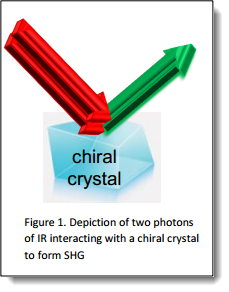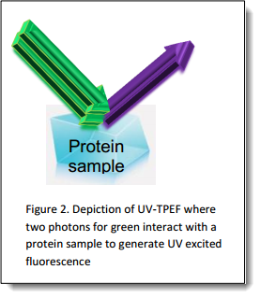
Second Order Nonlinear Imaging of Chiral Crystals (SONICC) relies on the underlying principle of Second Harmonic Generation (SHG) where two low-energy photons combine to form a higher-energy photon under intense electric fields (Figure 1). This process only occurs in noncentrosymmetric ordered crystals. Thus the signal is generated in the presence of chiral crystals with absolutely zero signal occurring from solubilized or aggregated proteins resulting in extremely high contrast images.

Nonlinear effects such as SHG require high electric fields, thus requiring the use of a femtosecond (fs) laser. The laser operates with a pulse width of 200 fs and has high peak powers resulting in nonlinear effects but are short enough to reduce damage associated with localized heating. Further efforts are taken to reduce sample damage by scanning the laser beam quickly so that it does not remain in one spot long enough to heat the sample.
The high contrast images obtained with SONICC are due to the specificity to noncentrosymmetric crystals which include chiral crystals. Chiral crystals are those that lack an internal plan of symmetry, and thus its mirror image is nonsuperimposable on itself. Only those samples that lack inversion symmetry will produce signal. Most salt crystals are symmetric and therefore generate no SHG. Also, all aggregated and solubilized protein will generate no SHG yielding extremely high contrast images.
The high contrast images generated by SONICC set it apart from conventional imaging techniques such as fluorescent and birefrigent imaging. Whether probing fluorescent tags or tryptophan, large background signals are generated with fluorescent imaging due to protein in solution or aggregated protein. Incompatible imaging plates that are commonly found with conventional techniques are no longer a problem, as SONICC is compatible with all optically accessible platforms. Fluorescent and birefrigent imaging is also limited to larger crystals (>10 µm) making it difficult to locate those conditions generating crystal showers. SONICC can detect crystals <1 µm allowing for the identification of many more conditions that can be optimized for protein crystal growth.

Some salt crystals including lithium sulfate and ammonium phosphate form noncentrosymmetric crystals and generate SHG. The use of UltraViolet –Two Photon Excited Fluorescence (UV-TPEF) can aid in the discrimination between protein and salt crystals.
This imaging mode takes advantage of the intrinsic aromatic amino acid residues (ex. Tryptophan) in the proteins. When excited with UV radiation the tryptophan in the proteins fluoresce making it very easy to determine whether or not a crystal is proteinaceous. In order to probe this fluorescence, the laser is doubled with a NLO (nonlinear optical) crystal from 1064 nm to 532 nm. The green light (532 nm) is then used to image the sample (Figure 2). The two photon equivalent of the green is 266 nm which excites any tryptophan amino acids that are present. The two-photon excited fluorescence (350 – 400 nm) is then collected and used to create a fluorescence image.
It should be noted that it is not necessary for the protein to be crystalline in order to fluoresce. In this way the SHG and UV-TPEF imaging modes act as complements to each other. The SHG channel probes crystallinity and the UV-TPEF channel is specific to proteinaceous samples.
Preliminary experiments show no detectable damage to protein crystals from the laser. In one experiment, a protein crystal was imaged on one half with excessive laser input. X-ray diffraction was obtained from both the exposed and un-exposed halves of the crystals. Both sides diffracted to within expected resolution (~2 A) and within statistical variation (i.e. there was no statistical difference between the diffraction of both sides).
SONICC has also been utilized to image live cells with no observed impact. The cells remained adhered to a Poly-Lysine coated slide before, during and after imaging indicating they remained viable.

|
|
| RIC-V38R119 |